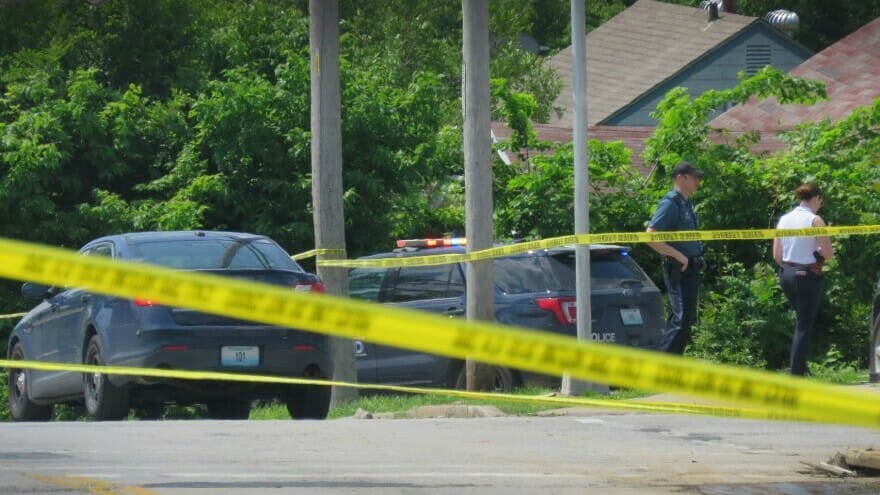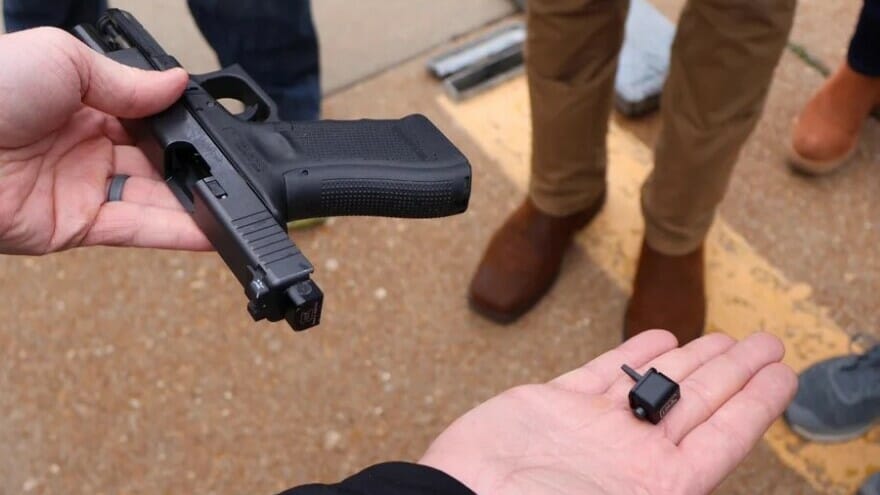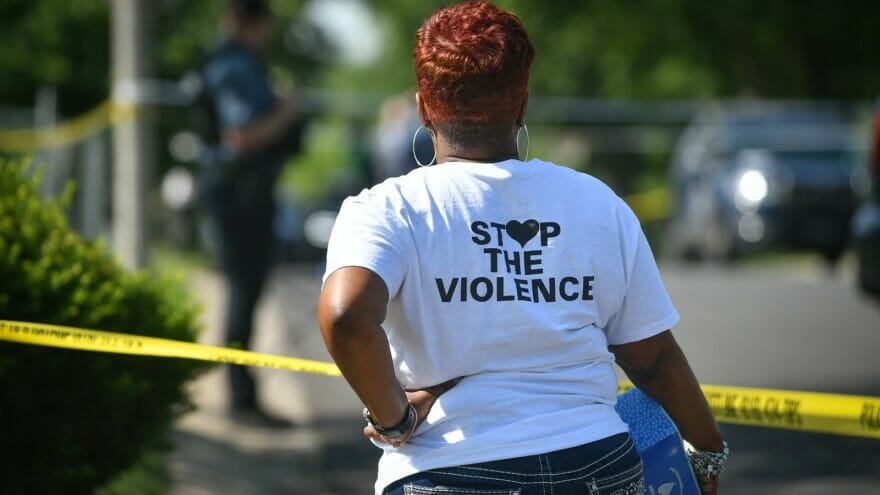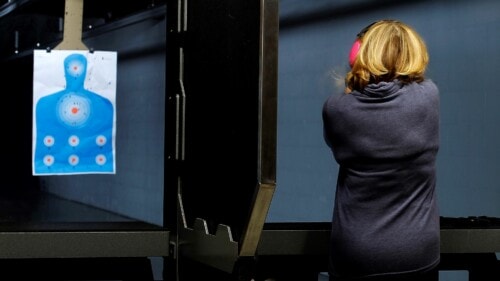Hundreds of Kansas Citians Are Shot Each Year and Survive. Families Pick Up the Pieces Since 2015, shootings in Kansas City that leave a survivor are rising slightly — meaning more families are struggling with the physical and mental wounds they cause.
Published September 27th, 2023 at 11:32 AM
Above image credit: A police line do not cross tape. (File photo)Marie remembers that day back in September 2017. She was on her lunch break, watching TV, and saw a breaking news report about a shooting at East 45th Street and Paseo Boulevard in Kansas City.
“I said, ‘Oh my God, I pray for whoever’s kid that is, their whole family,” she said.
She didn’t know it until hours later, but it was her 19-year-old son who had been shot. He’d been trying to remove himself from a group of friends for a while, and they weren’t having it. Marie’s son was hit ten times while he was parked at a gas station — his car had more than 35 bullet holes.
Marie nearly lost her son — and not just that one time.
In April 2022, her son faced a second round of retaliation, once again shot by the same people — they’d been locked up for the first shooting, but released five years later.
By some kind of miracle, Marie’s son is still alive. But Marie is now left to pick up the pieces of a 25-year-old man who is more like an eight-year-old, she said.
“He’s just not my son,” Marie said. “He’s in there, he’s inside hisself, but he’s not. The body’s there, but that’s not him.”
KCUR is not using Marie’s full name or her son’s name because she fears the same people will come after her son again. Marie is one of thousands of people who are dealing with the fallout from gunshot wounds leaving victims alive, but with severe physical and mental injuries.
Although non-fatal shootings are down so far this year from 2022, over the longer term, they have risen in Kansas City, thanks to few gun laws and a wave of machine gun-style weapons in the streets.
Since 2015, non-fatal shootings have grown by nearly 30%, from 414 that year to 537 in 2022, according to Kansas City Police Department data. The number spiked during the pandemic in 2020 when 630 people were shot but not killed. As of Sept. 10, there are 355 of what KCPD calls “living victims” this year.
Meanwhile, the homicide rate is on course this year to break the record set in 2020, when 182 people were killed.
Non-fatals Increasing or Staying Steady? Hard to Know

Natalie Hipple, a criminal justice professor at Indiana University, began working with the Indianapolis Metropolitan Police on non-fatal shootings around 2014. The police department was concerned about rising gun violence. She focused on the rising number of non-fatal shootings there and created a report for the U.S. Department of Justice.
Her first task was defining non-fatal shootings, since there’s no federal definition in either the FBI’s Uniform Crime Report or the National Incident-Based Reporting System — the large national data sets that law enforcement, researchers and others use to make decisions.
“I like to talk about it as bullet to skin,” Hipple said of her definition. “Somebody’s actually been shot by a projectile out of a gun and is still alive.”
Hipple said her next task was to focus on the data, in hopes of creating the most accurate numbers. Starting with police incident reports, she counted shootings by hand, digging through internal documents and trying to find “where are all the places these non-fatals can hide.”
“When we first started, we learned that domestic non-fatals went to the domestic violence unit. They didn’t come to the aggravated assault unit. So they didn’t get counted. So how do we get a hold of those (cases)?” she said.
She also wondered how Indianapolis police counted a non-fatal shooting in self-defense, since that’s not a crime.
“Where were those ending up? Were those getting counted? Because technically they’re not criminal. If it’s in self-defense, how do we get those out of the numbers?”
Because there is no federal definition, it’s hard to track trends nationally, since each city has their own way of gathering the information, she said.
“My general feeling is that non-fatals are either increasing or staying steady,” Hipple said. “I don’t feel like they’re decreasing, but I don’t know that we really know.”
Hipple is calling for a more holistic look at gun violence, creation of a national non-fatal shooting definition of “bullets to skin,” and better collection of data to gain information on who is involved, where the shootings are occurring, and why.
“You can’t fix what you can’t count,” Hipple said.
Switches: Making a Dangerous Weapon Even More Deadly

Melesa Johnson, Mayor Quinton Lucas’ director of public safety, said there are a couple reasons Kansas City has seen a rise in shootings overall. First, Missouri began loosening gun laws in 2007 — culminating in 2017, when the state began allowing anyone to carry concealed firearms in most locations without first obtaining a permit.
Second, Johnson said the recent dip in non-fatal shooting numbers is directly related to the increase in homicides, thanks to machine gun-style weapons and a new device turning up in the streets during the last year. A “switch,” or “chip” turns semi-automatic weapons into fully automatic guns that fire dozens of bullets with just one pull of the trigger.
KCPD officers report that it is now normal to see more than 100 shell casings and rounds at a crime scene, she said. In the past, there may have been around seven shell casings for each homicide, Johnson said.
“You are dealing with higher capacity weapons, whether they are actual AK-47s or machine guns that have actually been manufactured as machine guns,” she said, “but also semi-automatic weapons that are being converted into fully automatic weapons using what are called Glock switches or Glock chips.”
A KCPD spokesperson said the department began tracking the switches a year ago. So far, police have recovered 95 firearms that are capable of firing automatically based on some kind of alteration made after it was manufactured.
Metal chips can be purchased for around $30, but people can also get templates online and create them with a 3D printer, Johnson said.
“They turn an already dangerous instrument into a much more deadly instrument,” Johnson said. “So even though non-fatal shootings are down, homicides are up because each shooting is just that more deadly.”
Ripple Effects of Shootings are ‘Profound’

The second shooting of Marie’s son was particularly devastating, even though he was shot fewer times, she said. During the year since, he’s had three strokes, lost much of his memory and been placed in a psychiatric ward twice after breakdowns.
Her son has been diagnosed with depression and post-traumatic stress disorder, Marie said. She has him in a safe house and won’t let him come to her home, just in case the people who tried twice to kill him are watching. She said she wants to tell those attackers, “Y’all done did it. He’s done.”
Mostly, she’s angry at what she calls “the system.” It failed her, Marie said, offering victim services for just a couple weeks after the shooting, then nothing. She’s tried to get her son into long-term rehabilitation, only to be told her insurance is no good or it’s not covered by Medicaid. A few counseling sessions have led nowhere, she said.
“You get shot, you’re done, and you get threw back out into the world,” Marie said. “It’s Black-on-Black crime. So there’s nothing.”
“No one’s listening. There’s no program out here for people like him,” she said. “Because I know there are other families out there suffering like me and other people going through what I’m going through. And it’s so hard.”
More than 80,000 people survive firearm-related injuries each year in the U.S., more than double the 40,000 who are killed by gunshots annually, according to a 2020 report in the Journal of the American Medical Association.
Of those who survive, Harvard researchers found that the long-term and hidden costs of firearm injuries include substantial increases in poor mental health, substance use disorders, and health care costs. That includes survivors as well their significant others and children, the study found.
Dr. Zirui Song, an Associate Professor of Health Care Policy and Medicine at Harvard Medical School, told NPR that the research team found the results disturbing.
“The ripple effects are quite profound and meaningful for both survivors and family members and, I would argue, clinically and economically substantial,” Song said. “There is really an undercurrent of forgotten survivors whose own health and economic conditions are affected quite profoundly, even though they were lucky enough to survive.”

Marie is a good example of that. She said her son changed after his breakdown, hiding in his safe house, not able to work. He eats very little, as he’s paranoid about his food being poisoned. He won’t drink water from a bottle unless it has two protective caps, and he refuses to eat any food delivered by a service like DoorDash, she said.
“It takes a toll, on me, his sisters, people being scared of him,” Marie said.
Praying for Protection
Though she feels like she’s tried every avenue to get help for her son, Marie said she keeps digging, calling treatment centers and hospitals, trying to find some help. She calls her son often.
Each morning they read Psalm 91, which is about living under the protection of God. “You will come through the storm, you’ve just gotta let go and let God and he will deliver you,” Marie said.
Marie said she’s trying to stay positive. She reminds her son that he survived two shootings, and that was God protecting him.
“He just calls me all through the night and I’ll be so scared,” she said. “But I gotta talk to him, keep him, let him know like ‘Hey I love you,’ you know, that’s all I tell him, is ‘I love you, son. I love you. Things gonna get better.’”
Peggy Lowe is an investigative reporter who covers the criminal justice system for KCUR, a member of the KC Media Collective.




